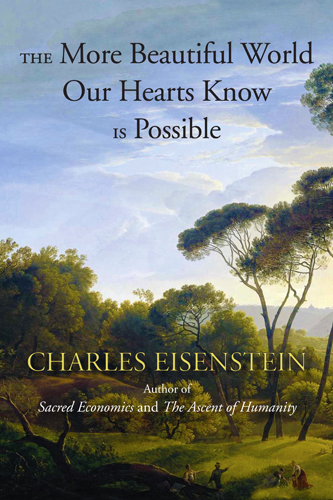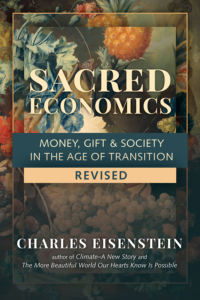Climate — A New Story
Chapters
Chapter 2: Beyond Climate Fundamentalism
The Mother of All Causes
When I wondered about the cause of the estuary die-off, a hypothesis may have jumped into your mind—climate change, the culprit du jour for nearly every environmental problem. If we could identify one thing as the cause, the solution would be so much more accessible.
As I was doing research for this book, I googled “effect of soil erosion on climate change,” and the first ten pages of results showed the converse of my search—the effect of climate change on soil erosion. I did the same for biodiversity, with the same result. Whether or not it is true that climate change exacerbates other environmental problems, the rush to name a unitary cause of a complex problem should give us pause. The pattern is familiar. It is none other than war thinking, which also depends on identifying a unitary cause of a complex problem. That cause is called the enemy, and the solution is to defeat that enemy.
Carbon reductionism is like “germ reductionism” in medicine. What is the cause of, say, strep throat? Well, obviously it is the streptococcus bacterium, right? Problem: germ; solution: kill the germ. On one level this may be accurate, but consider what this approach renders invisible and leaves out. First, it leaves out the question why one person exposed to the germ gets sick, and another does not. Especially if someone gets repeated infections of strep, it might be more useful to see the germ not as the cause, but as one of the symptoms of the disease. It also ignores the effects of repeated antibiotic treatment, and whether that might somehow contribute to vulnerability to reinfection. (This is not idle speculation, in light of recent science establishing the relationship between body ecology and immunity. Body ecology—which includes a healthy gut microbiome—is seriously disrupted by antibiotics.)
In medicine, focusing on the immediate, linear cause of a disease can vitiate the possibility of a real cure, whether on an individual or epidemiological level. Consider a disease that looms far larger than strep in our collective consciousness today: Lyme Disease. Seeing it as an infection by a tick-borne spirochete, the appropriate technologies of control are obvious: avoid or destroy ticks, and kill the spirochete. To see the problem in another way can be very inconvenient or disruptive to the systems that embed the usual control-based responses. What is the real “cause” of Lyme? I don’t know, but it could include the following:
- Compromised immunity that leaves the body vulnerable to numerous viral coinfections (against which antibiotics are useless)
- The explosion of deer tick populations due to increasing “edgelands” and loss of deep forest caused by suburban development
- Exploding deer populations caused by the extermination of wolves and cougars
- Declining forest health and understory degradation caused by pollution, repeated clear-cutting, and again predator extermination (deer destroy the forest understory when their numbers are unchecked by predation), which in turn devastates biodiversity and allows overgrowth of species like ticks
- Decline of pheasant and other tick-eating birds, because of historical overhunting, roadkill, and understory destruction
- Widespread aerial spraying of insecticides to control gypsy moth caterpillars and other insects, decimating insect-eating birds
- The exteriorization of modern fear of nature; it is as if nature responds to our locking children in the safety of indoors by saying, “Okay, I’ll give you something to be afraid of for real.”
We can dig deeper and deeper. What is the cause of suburbanization? What is the cause of pollution? What is the mentality behind the extermination of top predators and the spraying of forests? Complex, nonlinear causal relationships connect these phenomena. For instance, the othering of nature encourages suburbanization, but it is also the other way around. Cut off from direct relationship to the land, the suburbanite who buys food grown thousands of miles away and needn’t even tread the soil to move from place to place will of course see nature as a spectacle or a threat.
One might even say that “the cause” of Lyme is everything and anything. Even the locution “the cause” is part of the problem, as it implies the separability of interdependently co-arising phenomena. I could even say the cause of Lyme Disease is modern children’s storybooks that present us from a young age with anthropomorphized animals wearing human clothes, living modern lives, and thinking human thoughts. Such storybooks entice us to take other beings on our terms and not theirs, and obscure the fact that the human normality that the storybook animals are playacting is extinguishing the actual habitats of those animals in the real world.
Now I am not saying that one should never address an obvious, linear cause, just as I am not saying that there is never a time for a fight. I am warning, rather, of the habit and conditioned response of addressing all problems in this way.
In ecology, which is the study of relationships and not things, every cause is also a symptom. Let’s take for example the steep decline of seagrass meadows, which are biodiversity hotspots and sequester more carbon per hectare than nearly any other ecosystem. Seagrass die-off is a cause of carbon loss and acidification, and it is a symptom of:
- Proliferation of herbivorous mollusks and crustaceans, caused by the overfishing of larger predatory fish
- Eutrophication and algae blooms, caused by excess agricultural runoff
- High levels of silt that reduces seagrass’s access to sunlight, which is a consequence of soil erosion, which is a consequence of modern agricultural practices, logging, and development
According to a friend who works with “watermen” (mostly crabbers) on the Chesapeake Bay, seagrass, shellfish, and crabs experience a massive die-off every time there is a hurricane or severe influx of highly sedimented freshwater into the bay. These irregular disruptions keep the ecosystems ever precarious. Well, that wasn’t much of a problem a few centuries ago, because:
- Intact wetlands could absorb massive amounts of rainfall.
- Beaver dams along all the small tributaries to the bay slowed runoff and trapped sediment.
- Deforestation and tillage had not exposed bare topsoil to erosion.
Clearly, protecting and restoring seagrass is more than a matter of roping off protected areas, because seagrass is in relationship with everything that lives, including ourselves. Nor will our normal find-an-enemy strategy save the seagrass. It is tempting and convenient to blame the problem on “more intense hurricanes caused by global warming,” ignoring the complex of causes that intimately involves ourselves and the way we live. It is also easier to blame the watermen for their supposed greed, ignoring the complex economic causes (in which, again, we all participate) that drive the relentless conversion of nature into commodity into money. Our intellectual habit is to find the One Cause, our scientific programming is to measure it, and our political gearing is to attack it. When the One Cause is global, we cross our fingers and hand over responsibility and power to distant global institutions. They’ll take care of it. We hope. But too often, blaming climate change means not doing anything at all.
Like most binary distinctions, that between symptom and cause breaks down under close scrutiny. Yet the distinction is still useful. Causes are symptoms and symptoms are causes, yes. So let us name as “symptom” that aspect of the cause/symptom complex that presents itself most obviously to our attention. To us, Lyme is calling most loudly. To another culture, the most alarming change might be the disappearance of the dogwoods in the mid-Atlantic forests, or perhaps some change in the songs of birds that you and I would never notice. Thus, what we observe to be happening in the world says as much about ourselves as it does about the world. It reveals what we think is important, significant, valuable, and sacred, and what is irrelevant or useless too. Put another way, what we see reveals how we see.
Nerdy aside: I am not in this book (or anywhere) taking the postmodern position that reality and truth are human cultural constructions—that how we see is the only determinant of what we see, or that there is no is-ness outside human seeing. Maybe the postmodern philosophers are right that there are no facts, but only meanings loaded with power dynamics, gender and racial oppression, etc. But what they cannot countenance is that we humans are not the only meaning-makers, not the only authors, not the only full subjective agents. Our ways of seeing, our stories and our myths, come from a source beyond our comprehension.
Among the many causal narratives available to apprehend Lyme, or climate change, or any other issue, our culture chooses the one that best preserves the status quo. The dominant culture adopts the narrative that sustains its dominance.
People tend to conceptualize problems in such a way as to validate the tools that are familiar and available to them. If all you have is a hammer, everything looks like a nail. If all you have are antibiotics, you will always look for the germ. If all you have is the mindset of war, then you will always look first for an enemy.
Our society’s most potent and familiar tool is the quantitative methods of science. That is therefore how we frame the problem of climate change. We use numbers (such as average global temperatures) to prove it is happening, other numbers (CO2 emissions) to formulate responses, and yet other numbers (embedded in computer modeling) to forecast the future and guide policy. But is this the only tool? Is this even the right tool? We might doubt it, given the damage industrial civilization has caused the planet depends on the same regime of quantification. Through science we describe the world in numbers and mathematical relationships. Through technology we apply those numbers to the control of the material world. Through industry we convert the world into commodities, characterized by numerical specifications. Through economics we further convert all things into another number called its value.
We would like to solve climate change with methods and mindsets that are familiar to us, for to do so would preserve the foundation of society as we know it. These methods and mindsets, the quantified worldview, tell us that we can fix the situation by eliminating fossil fuels. Unfortunately, as I will discuss later, the mere elimination of fossil fuels will not deliver us from the ecological crisis. A deeper revolution is afoot.
Eliminating fossil fuels does not represent as thorough a change as the change required to halt ecocide here, there, and everywhere. Conceivably, we could eliminate carbon emissions by finding alternative fuel sources to power industrial civilization. It may be unrealistic upon deeper investigation, but it is at least conceivable that our basic way of life could continue more or less unchanged. Not so for ecosystem destruction generally, which implicates everything upon which modern technological society depends: mines, quarries, agricultural chemicals, pharmaceuticals, military technology, global transport, electronics, telecommunications, and so on. All of these must evolve into their next incarnation; some may even become obsolete.






